Elizabeth de Carvalhaes
Executive President of Bracelpa (The Brazilian Pulp and Paper Association)
Op-AA-22
It’s time to think about the future we want
A major turnaround in consumption and in terms of the consumer. The most important climate negotiation of our time will cover this subject matter in depth, when it will lay out the future of the 21st Century and do a sketch of how the planet might be for the generations to come. Less eagerness to consume and more concern with the quality and origin of products, the option for less space, albeit better qualified and useful, in addition to other changes in behavioral standards, are expected to design a new human being and also to orient policies and markets from now on.
Brazil will be one of the main focal points at the 15th Convention of the Parties at the United Nations Framework Convention on Climate Change (COP-15), a multilateral negotiation that will discuss global climate policies and will define, for each country, limits for greenhouse gas (GHG) emissions. This forum will be a great opportunity for Brazil to reinforce its low carbon economic model and, in this context, the tripod comprising planted forests, agriculture, and bioenergy, offers important solutions in mitigating global warming.
This argument has constantly been reinforced by Bracelpa - The Brazilian Pulp and Paper Association in all recently attended fora, both local and international. It has also been brought up by the 15 sectoral entities that comprise the Brazilian Climate Alliance – Agriculture – Bioenergy – Planted Forests -, whose objective is to propose concrete actions for the COP-15 negotiations, based on the Brazilian government’s agenda.
In the climate debate, the main issue concerning the pulp and paper industry is to show the world how forests contribute to reducing the effects of global warming. With two million hectares of planted forests – the most productive and sustainable in the world – these biomes absorb and store some 64 million tons of carbon per year, i.e., they offset GHG emissions to the atmosphere.
The number is even larger if one considers the entire forest base planted in the country, which adds up to 6.6 million hectares. This is an impressive contribution to the climate, which current climate policies do not value. However, COP-15 will provide the industry with opportunities to change this concept. At this point the negotiation is afforded an economic perspective of global impacts.
If it turns out to be favorable to planted forests, carbon credits may be sold to companies to offset excessive GHG emissions. Currently, the main carbon market in the world, the European Union, does not view CO2 absorption by forests as a legitimate offsetting of emissions. Sustainable development in light of the creation of a low carbon industry is something the pulp and paper industry has been seeking to achieve for decades.
Thirty-year old data already shows the industry’s interest in improving its processes by replacing the use of fossil fuel with renewable fuel. The restructuring of the energy matrix greatly reduced the use of fossil fuel, which decreased from 49%, in 1970, to only 6% of its base, in 2008. This means that nowadays 94% of the energy used by the industry comes from clean and renewable sources.
One should further mention that new projects, still under consideration, are expected to improve the use of biomass in processes such as energy cogeneration, increase in the burning capacity of black liquor in recovery boilers, the treatment of effluents (avoiding the emission of methane) and Clean Development Mechanisms (CDMs) — for compostable residues and the reutilization of heat.
Other industry mitigation initiatives involving climate change imply high investments in research and development, the surveying and publicizing of a sectoral carbon inventory, the sale of carbon credits into voluntary markets, in addition to the creation of a policy capable of reducing carbon emissions in the manufacturing of products.
In recent years, CDM projects – particularly as related to the substitution of fossil fuel by fuel obtained from renewable sources – reduced emissions, generated carbon credits around the world and also allowed developed countries to offset their emissions by purchasing credits from the pulp and paper industry.
The interest of Brazil’s productive sectors in this subject matter is big, given that the country currently ranks third in the number of CDM projects in the world, with other 295 under analysis. The number is only not larger than that of China or India, the countries leading the ranking in registered projects, because the Brazilian energy matrix currently already is one of the cleanest of all: more than 40% of its content is originated in renewable sources.
Brazil will attend COP-15 with the challenge of resolving the issue of illegal deforestation. On the other hand, the incomparable natural patrimony that places the country in a sovereign position for the negotiations shows an unprecedented environmental and energy balance. For the pulp and paper industry, that directly handles the main asset of the economy of the future – renewable natural resources, that absorb and recycle carbon – it is imperative that it secure for itself a distinguished position in this scenario.




